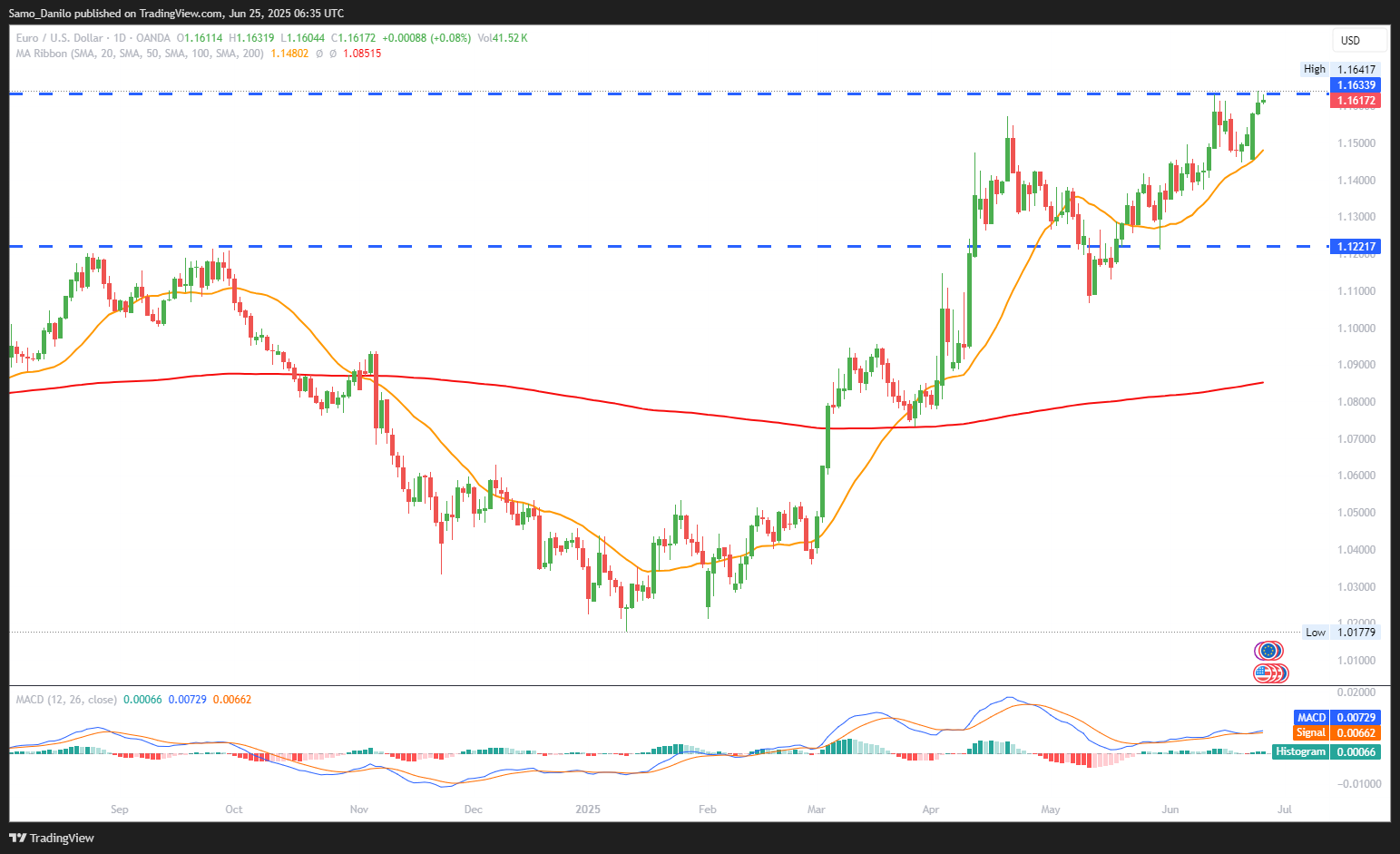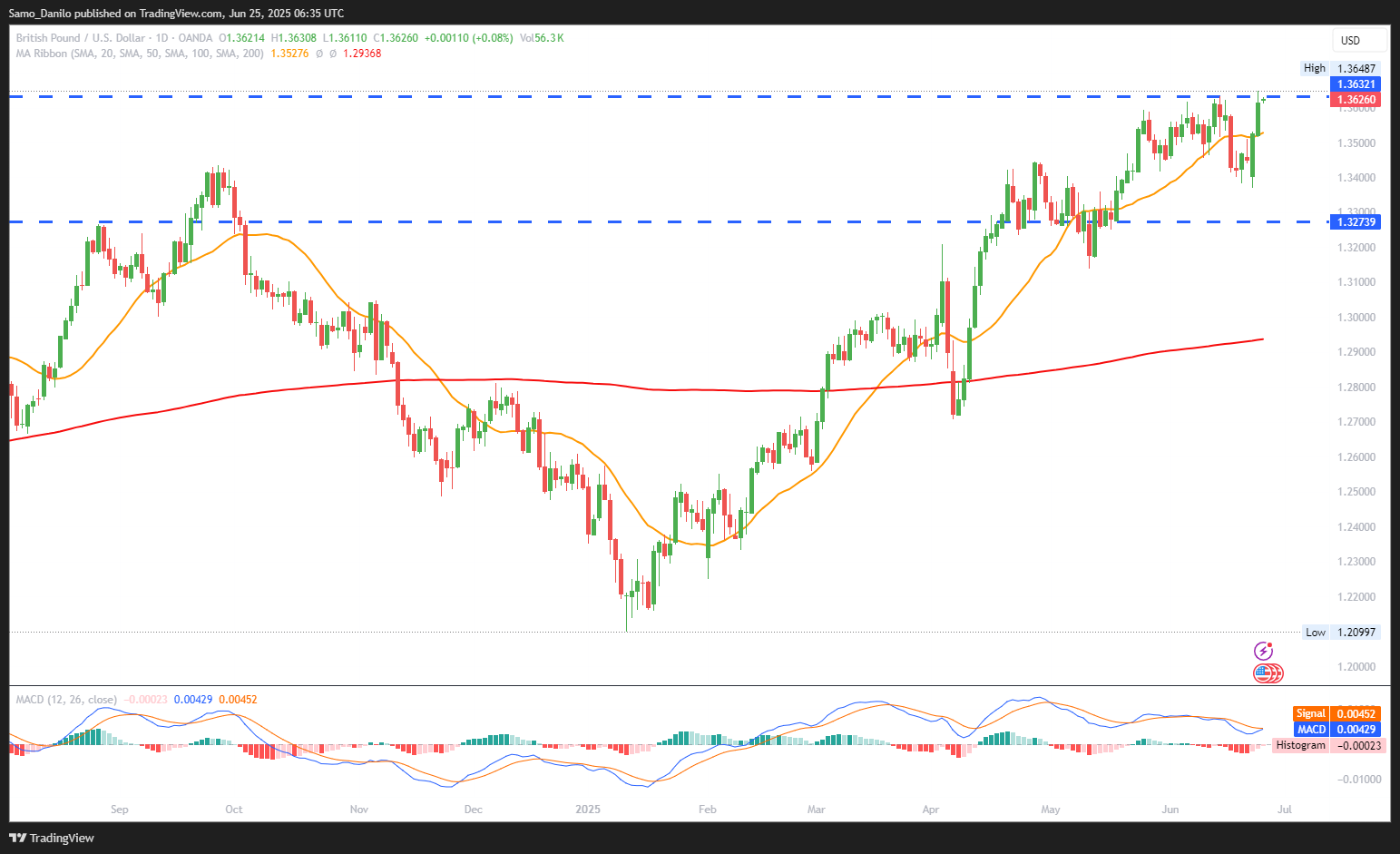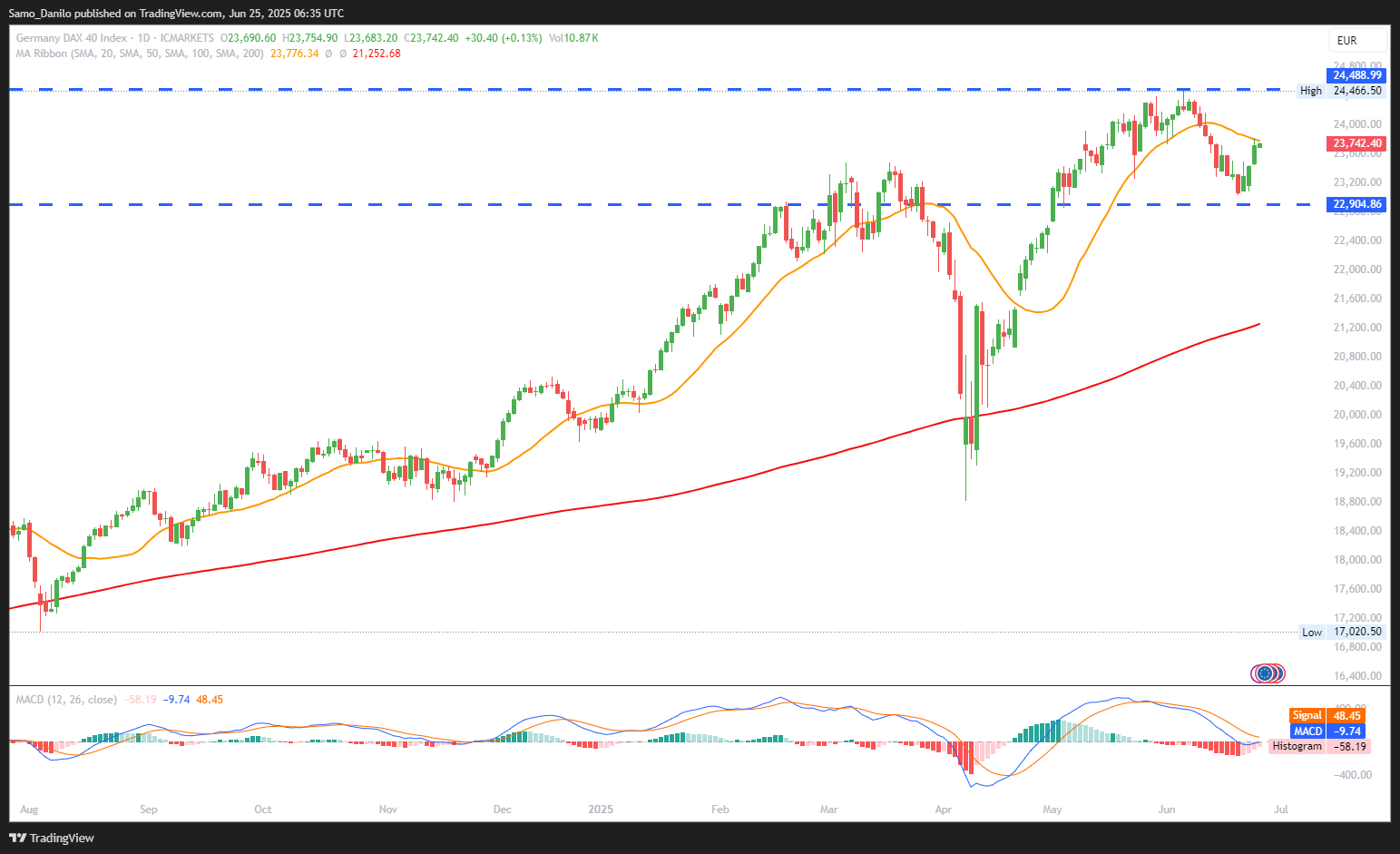EURUSD
- EUR/USD Price: The EUR/USD pair traded near fresh 2025 highs, briefly touching the 1.1640 level before retreating modestly to around 1.1610 in early European trading. The pair remains supported by broad-based USD weakness and ECB optimism.
- ECB’s Lane: ECB Chief Economist Philip Lane stated that the central bank is confident inflation is broadly under control, though noted services inflation still requires attention. His comments reinforced expectations that the ECB's rate-cutting cycle may be nearing its end.
- Eurozone PMIs: Preliminary June PMI data showed manufacturing holding at 49.4 and services at 50.0, suggesting stable but subdued business activity. The Eurozone economy continues to hover around the contraction/expansion threshold, limiting euro upside.
- Fed Rate Cut: Investors have increased bets on a Federal Reserve rate cut, with futures pricing a 22% chance of a July move, up from 14% last week. Dovish Fedspeak and soft US data are driving the sentiment, contributing to downward pressure on the USD.
- Light Calendar: With little on the European data docket—limited to Spain's final Q1 GDP and Switzerland’s UBS investor sentiment—market flows and risk sentiment are expected to dominate today’s trading direction.
Closing statement: The EUR/USD remains buoyant near year-to-date highs, driven by rising Fed cut expectations and firm ECB messaging. However, cautious PMI results and a light macro calendar could temper further upside in the near term.
GBPUSD
- GBP/USD Price: The GBP/USD pair rose for the third consecutive session, trading around 1.3620 during Asian hours on Wednesday. The upward momentum is fueled by US Dollar softness and increased expectations of Bank of England rate cuts.
- BoE's Bailey: BoE Governor Andrew Bailey cited slowing wage growth and rising economic inactivity, but flagged concerns about labor data reliability.
- BoE's Ramsden: Deputy Governor Ramsden reinforced the dovish tone, highlighting labor market loosening and giving weight to downside economic risks.
- Fed’s Powell: Fed Chair Jerome Powell indicated that rate cuts are possible, yet emphasized price pressures likely rising in Q3, which undermines expectations for a July rate cut.
- Fed's Schmid: Kansas City Fed’s Schmid echoed the cautious tone, suggesting the Fed should wait for more clarity on tariff-related economic impacts.
Closing statement: The GBP/USD rally continues, driven by dovish BoE commentary and tempered Fed optimism. However, the pair’s direction will hinge on evolving central bank rhetoric and market sensitivity to inflation and labor signals.
XAUUSD
- XAU/USD Price: Gold (XAU/USD) continues to trade on the back foot, nearing the $3,300 mark during early American trading. Persistent risk-off sentiment fails to support gold, which remains under pressure despite geopolitical tensions.
- Israel-Iran Ceasefire: Despite Israel accusing Iran of violating the ceasefire by launching missiles—an allegation Tehran denies—gold fails to attract safe-haven flows, suggesting markets remain unconvinced of imminent escalation or are reacting more strongly to Fed signals.
- Fed's Hammack: Cleveland Fed President Hammack reiterated the preference for a patient rate stance, cautioning against premature moves.
- Fed's Williams: NY Fed's Williams forecasted inflation at 3% in 2024, returning to 2% only by 2026—dampening expectations for near-term rate cuts and pressuring gold further.
- Consumer Confidence: The Conference Board's Consumer Confidence Index fell sharply to 93.0 in June from 98.0 in May, missing expectations. The decline reflects deteriorating views on both current conditions and future outlooks, possibly signaling a fragile economic undercurrent.
Closing statement: Gold remains under downward pressure, even as geopolitical risks rise. With Fed commentary tilting hawkish and economic data sending mixed signals, gold’s direction will hinge on how markets interpret the balance between inflation risks and global instability.
CRUDE OIL
- Crude Oil Price: WTI crude extended its sharp decline, dropping nearly 3% on Tuesday, after a 13% sell-off on Monday, retracing from above $77.00 to $64.00. The sharp pullback reflects a rapid unwind of the geopolitical risk premium.
- Israel-Iran Ceasefire: Oil markets found relief after Israel and Iran confirmed a ceasefire, ending a 12-day conflict. Israeli PM Netanyahu declared the country had met its war objectives, while Iran's acceptance of the deal eased fears of further supply disruption in the Middle East.
- Strikes in Qatar: Despite Iran’s retaliatory strike on the US Al Udeid base in Qatar, the absence of casualties and successful missile interception led traders to avoid panic, contributing to oil’s continued retreat.
- US Inventories: API survey revealed a significantly larger-than-expected draw in US crude supplies for the week ending June 20, with energy firms reportedly pulling 0.8 million barrels, which could limit further downside in prices if confirmed by official EIA data.
- Kazakhstan Supply: On the supply front, Kazakhstan’s KazMunayGaz revised its 2025 output estimate for the Tengiz oilfield higher—from 34.8 to 35.7 million metric tons—signaling increased supply potential from non-OPEC producers.
Closing statement: With Middle East tensions de-escalating, oil prices are correcting sharply from war-driven highs. However, inventory drawdowns and higher future production estimates may reintroduce supply-side dynamics into the price narrative. Volatility remains likely in the near term.
DAX
- DAX Price: On Tuesday, June 24, the DAX surged 1.60% to close at 23,642, marking its highest close in over a week. The rally came amid upbeat macroeconomic data and strength in banking and industrial stocks.
- Index Stocks: Deutsche Bank led the index with a 5.34% gain, followed by Commerzbank at +2.28%. In the auto sector, Daimler Truck rose 3.52%, while Mercedes-Benz, BMW, and Volkswagen posted gains. However, uncertainty surrounding US-EU trade policy capped upside potential for BMW and VW, and Porsche ended in the red.
- Business Confidence: The IFO Business Climate Index for Germany rose to 88.4 in June, beating expectations (88.3) and up from 87.5 in May. The Expectations sub-index also surprised to the upside, improving to 90.7 vs 88.9 prior, reflecting cautious optimism in corporate sentiment.
- Fed Stance: Kansas City Fed President Schmid reiterated a “wait-and-see” approach, noting the central bank needs more time to assess the impact of tariffs on inflation before making a policy move. This aligns with broader market expectations for near-term policy stability.
- Powell’s Testimony: Investors await Fed Chair Jerome Powell’s second day of testimony on June 25, looking for consistency or shifts in tone that could influence global equity and currency markets, especially given the sensitivity around rate path expectations.
Closing statement: The DAX posted robust gains on the back of strong sectoral performance and better-than-expected business sentiment data. However, lingering trade uncertainties and Fed policy ambiguity could temper momentum in the sessions ahead.




